Intel X58 Motherboard Roundup - What does $300 Get You?
by Gary Key on December 5, 2008 3:00 PM EST- Posted in
- Motherboards
EVGA X58 SLI
Features
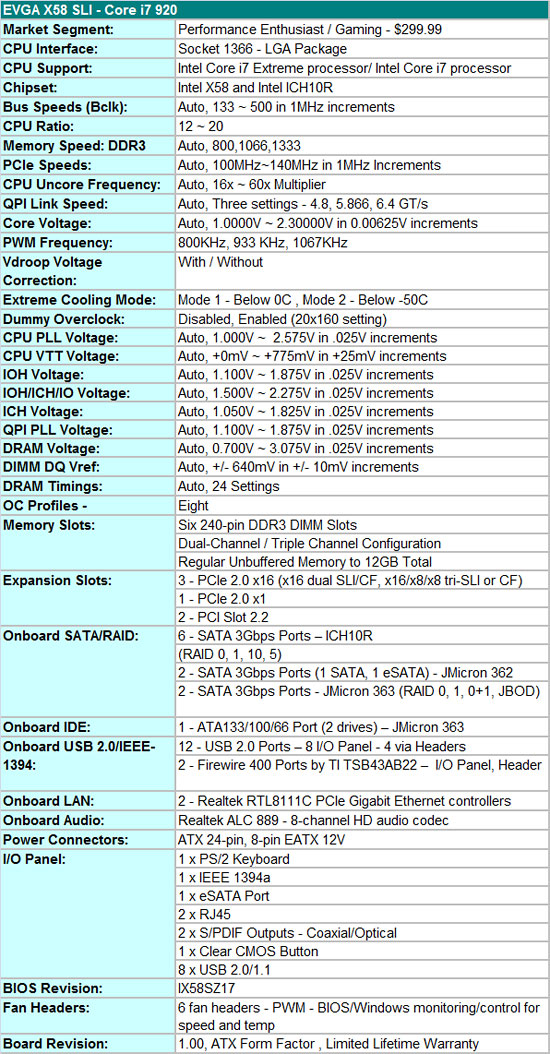
There aren't too many bells and whistles on the EVGA X58 SLI from a hardware feature viewpoint, and considering the market for this board we think that's a good design choice. The almost universal Realtek RTL-8111C PCIe Gigabit Ethernet controllers are utilized in tandem; the Realtek ALC-889 is on board for HD audio; and JMicron’s JMB362/363 chipsets get the nod for eSATA, IDE, and additional SATA port duties. TI is selected for IEEE 1394a support and the Intel ICH10R is utilized for primary storage purposes. We have never been real big fans of either Realtek audio or JMicron IDE, but considering the dearth of competition in the onboard peripheral market, you make do with the provided choices.
The BIOS is designed to get the most out of the board when overclocking. At first glance, some of the available options like the number of memory timings seem sparse compared to the ASUS and Gigabyte offerings. However, EVGA does a very good job of setting sub-timings to optimal points so far in our testing. We still prefer the ability to set additional memory timings and skew levels ourselves, but we can certainly live with the decisions made by the BIOS, although those at the bleeding edge of benchmarking would probably prefer the additional control level in either the ASUS or Gigabyte products. We just received BIOS IX58SZ17 that features additional memory settings and fine tuning options. We will update our comments and results once we have finished testing.
In a nod to the users who like to cool their systems via cascade or LN2, EVGA provides two different modes to properly set the board at POST for sub-zero temperatures. Those who love or need voltages to improve clock speeds will not have any problems with the choices provided by EVGA. DRAM voltages sky rocket up to 3.075V and VCore goes to a nice silicon melting 2.3000V. VDroop control can be enabled or disabled. In fact, the board has a tendency to slightly overvolt with VDroop control disabled.
Also, you can fine tune the frequency level on the digital PWMs. We normally left it at 800KHz to help reduce temperatures in the CPU area but switched to 1067KHz when overclocking our i920 past 4GHz. We were able to get an additional 80MHz out of our CPU on air by switching from 800 to 1067 once we passed 4GHz. EVGA also provides a setting called a dummy overclock; quite simply, enable this setting and the board will set itself to run a 20x160 overclock on the i920. We found the settings to be perfectly stable during benchmark testing, though obviously that's a far cry from what manual overclockering can achieve.
EVGA also supports a stock 1333MHz memory speed on the i920/i940 processors along with opening up QPI link speeds from a standard 4.800 GT/s up to 6.400 GT/s, which is standard on the i965 Extreme processor. We were disappointed with the lack of OC profiles in the initial BIOS, but the latest BIOS allows a total of eight profiles to be saved.
Finally, the board fully supports 12GB of DDR3 memory. We have not had any real problems running 12GB of our Patriot or G.Skill DDR3-1600 kits at 1600 with 8-8-8-24 1T timings, although we needed about 1.70V for absolute stability. Dropping the command rate to 2T allows 1.65V operation with the current BIOS.
One last item of note is that the three PCI Express 2.0 x16 slots will operate in x16/x16 mode for 2x SLI/CF if the third x16 slot is empty. If you decide to place a PCIe RAID, network, audio, or TV tuner card in the third x16 slot, then a 2x SLI/CF configuration will operate in x16/x8 mode. We did not notice any performance differences between the two modes with our HD 4870 or GTX 260 cards. 3x SLI/CF configurations will run in x16/x8/x8 mode. You can also use the first and third x16 slots for graphics if you need to open up a PCI slot but the board will run in x16/x8 mode. Although the owner’s manual states the three x16 slots are for graphics cards only, we had no problems running our ASUS Xonar D2X or Highpoint Rocket RAID cards in x16 slots two or three.
The Board
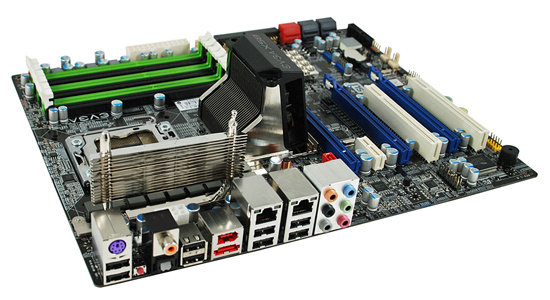
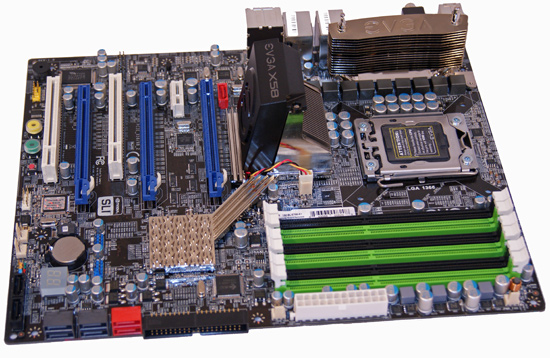
The primary design goal from EVGA was to allow 3x SLI/CF operation without needing a special case design to make room for the bottom video card. Put simply, this board will allow tri-card installations in most ATX cases but at the expense of rendering the additional PCIe and PCI slots physically unusable.
Keep that in mind when trying to figure out why EVGA located the lone x1 PCIe slot next to the first x16 slot. EVGA might as well have left it off the board (the same holds true for the other boards) and saved some money. We assume just about any owner willing to pay $299.99 for the board, at least $300 for a CPU, and $250 or so for 6GB of DDR3 will not be running a single slot GPU. In fact, unless you are going all out to set up up a folding machine or something similar, any GPU choice under an HD 4870 or GTX 260 is just a waste on this setup. Fortunately, the other PCIe x16 slots double for peripheral duty so those are available if needed.
The northbridge heatsink is fairly large and actively cooled. We could not hear the fan over our HD 4870 card, so noise should not be a problem. We were able to comfortably fit our large air coolers on the board without too much trouble once the PWM heatsink was moved slightly. The PWM heatsink looks nice, has an impressive EVGA logo stamped on the top fin, and is generally a pain in the you-know-what to work with when installing the 8-pin ATX power connector, large CPU heatsinks, or during case installation. It does a nice job of keeping the digital PWMs cool, but we just think something in a low rise design would have been better suited.
Some will wonder about the positioning of the 8-pin EPS12V power connector since it is a tight fit for most cables and the CPU fan header is right next to it just to make matters more interesting during installation. The position was chosen to provide the quickest and most stable power path to the CPU. We understand the reasoning and support EVGA’s decision, but a different PWM cooling solution would have made life easier.
Other than the above, the layout is very good and works well for us in a variety of cases. The board does come with power, reset, and clear CMOS buttons. In fact, two clear CMOS buttons are provided, one on the bottom edge of the board and the other on the IO panel. A handy LED debug display is available and six of the nine SATA ports are provided in a right angle setup.
The Application
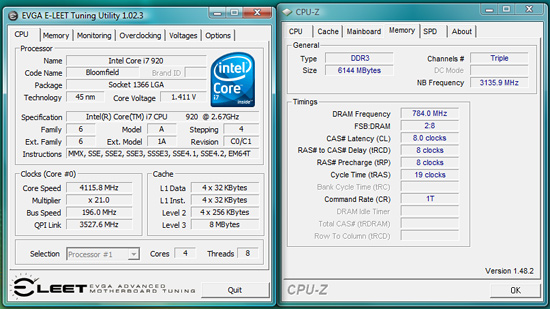
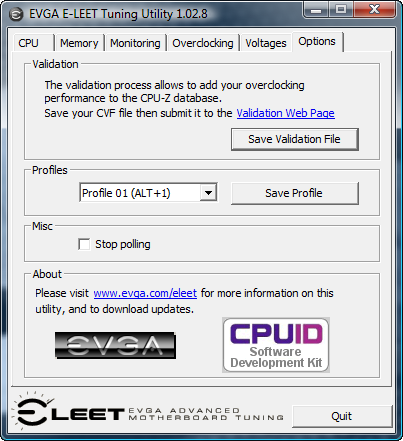
The ability of a board manufacturer to provide unique hardware or software features helps to differentiate products based on the same hardware. EVGA is hard at work in fully developing their Windows based on-the-fly overclocking utility. The application is known as the EVGA E-LEET Tuning Utility. We tested with version 1.02.08 that features profiles that can be saved and then applied quickly with a simple hot-key combination.
The E-LEET tuning utility was created with the CPUID software development kit, so users of CPU-Z will feel right at home. In fact, the utility will create a CVF file that can be submitted for validation to the CPU-Z database. There are six tabs with CPU, Memory, Monitoring, and Option being informational in nature. The Overclocking and Voltages tabs are where the action is with this program. The Voltages tab allows all of the major voltages to be changed on-the-fly and the Overclocking tab lets you adjust Bclk (QPI) , PCIe bus speed, and Turbo mode. Turbo mode selections cannot go higher than what the processor allows.
We found the utility to be handy in squeezing out that last Bclk step and to help ensure voltages are properly set at each overclocking step. The changes are not saved to the BIOS or a BIOS profile (hint, hint) and at this time the user will need to power down their system when exiting Windows to properly clear/reset the clock generator. We would like to see the ability to change the CPU multiplier and memory settings in future updates. Otherwise, the utility is very helpful but not a knockout, need-to-buy-the-board type of tool yet.






















78 Comments
View All Comments
TeXWiller - Friday, December 5, 2008 - link
Are you sure the 6 DIMM configuration is even supported with the current Nehalem at DDR3-1333 speed? Supermicro X8SAX, for example, does not support 6 DIMM configuration over DDR3-1066 speed, which is also the maximum Intel supported speed. This might explain some of those POST related problems.javamann - Friday, December 5, 2008 - link
I usually go for the high end board but I don't overclock. I expect if a board is built to run at a higher speed running at a normal speed would sit in the middle of the bell curve of it operating parameters. I would also expect it to just work. My bad.mjz - Friday, December 5, 2008 - link
not having support for 24GB ram of the bat is ridiculous.. With DDR3 ram going to be at a decent price next year, why not??? having 15GB as a ram disk would be amazing for many people.. this is MB companies being lasyAeroWB - Friday, December 5, 2008 - link
"Hey guys, Anand here. I'm writing this sub-section, not at Gary's request, but because I felt it was necessary."I totaly agree with you here, thanks for letting us know the size of the problem and Gary thanks for all those fixes.
"The point being is that we feel the lack of quality assurance before a product hits the market has now reached an all time high."
I do believe this is true, and I also have to say that I'm having problems with these kind of things for quite some years now, and I'm getting sick and tired of this.
For me the crap kickstarted in 2001 with an MSI mainboard, one brand I will never buy again...
(2001) MSI K7N420 Pro, it took MSI half a year to fix the issue of not being able to run the ram in dual channel mode on default speed without data corruption (the year I learned about memtest86) Also this board could not boot from an LSI 21320-R SCSI card and that problem has never been fixed (the Asus board with the same chipset could do it but my attempt to put that bioscode in the MSI bios failed)
(2003) Asus A7N8X-E Deluxe. onboard Marvell Gigabit card corrupted data, about one bit each 2GB so all my DVD downloads were corrupt! at 100Mbit it worked ok, an add-on Gb card also worked ok, lots of bios updates, no solution. Here's probably too much controllers cramped in not enough space. After 3 years upgrading the ram to 2GB didn't work, tried a lot of different brands. Bought an Intel D975XBX. (but the asus did support my LSI SCSI card!)
(2005) SuperMicro PDSGE, I finally bought a board with PCI-X for my Netware Server with SmartArray controller (which before was running in an Intel D945GTP desktopboard on PCI). The SmartArray card would boot, I got 2 special biosses for the board from Supermicro (great supportteam) but could't get it to work so added extra disk to boot the system, problem never solved. but it seems strange the controller working on a desktopboard and not on a server board. Updating the SmartArray also didn't help, My server still runs this board but now has a never HP SmartArray 641 that does work.
(2008) Asus M3A78-T, Razer Lachesis mouse is not working when powering up, I have to reinsert the usb connector of it everytime I start the computer to get it working (standby doesn't help) In 4 months I have flashed 3 newer bios versions in the mainboard and 2 in the mouse. Problem still exists. The Lachesis works fine in my IntelD975XBX system. My Razer Copperhead works fine in both (so I swapped the mice)
All listed boards are only from my private systems, I work at a computershop for over 10 years so needless to say I saw much more bios/board misery.
So far I have had the least problems with Intel boards but they also have their share of problems. Some years ago the company switched from Asus to Intel partially because alot of customers sometimes accidently overclocked their system (the boards got into the bios if they thought the post failed) and it got unstable. I really do not get why there are so many overclocker options while 90% of the people doesn't use it and just want a stable system. If for example I now look at Asus' website I almost get a heart attack, there are just too many mainboard models, most are not interesting at all, too many useless onboard crap, too expensive, absurd features (Aopen tube board for example), crap quality chipsets, etc. And in all that mess there's no board without overclocking and quality components except maybe some Intel models. Try to find a board that will get your vidcard and soundcard a real free non-shared interrupt, you can't. So there is too many stuff and not enough simple quality models. How can they test and support all those models, well they can't as we know now. They don't update drivers for their chipsets and onboard junk, so you have to search yourself. It looks like they haven't got enough time to do it good so why not make less models and get it working right. All of this holds true for many brands not only Asus. Maybe the economic crysis will have a positive side-effect of getting less different models but better supported and tested components.
Only pointing the finger at the manufacturers however is too easy.
Lots of review-sites focus on speed and overclocking, exagerating speed differences, over-hyping all kind of not-so-usefull onboard junk. Its all speed and quantity for the least money, so boards come factory overclocked, memory timings set to tight, onboard controllers that almost no-one needs etc. Just so it looks they provide more bang for the buck then the competition and get a better review score.
Lots of customers want the most speed and features for the least money, and forget about quality, support etc. Manufacturers look at the market and provide the crap that people scream for to get bashed by those customers for the crap, that will still buy the cheapest stuff next time. so the demand for shit doesn't decrease so the shit is provided again....
chizow - Friday, December 5, 2008 - link
I've felt the motherboard industry has been the weakest link in the PC industry for a very long time. I'm really glad someone finally called them out on it.I used to get REALLY upset at AT reviews because they'd publish a review making it seem these boards are rock solid stable with insane overclocking ability only to learn the ugly truth once I got the board home. It wouldn't take long to confirm it with other reports of underwhelming performance totally out of line with various reviews.
BIOS stability and quality certainly needs to improve, especially if board makers want to charge such insane prices for something that has always seemed low-end and interchangeable. Its probably a good thing that the market for mobo makers has shrunk, now they can focus on quality and add some value by making these things last longer than 6-9 months.
haukionkannel - Friday, December 5, 2008 - link
When I bought last time purhaced new PC. It had vorce USB support that I can imagine. Every time I put an new USB devile like USB stick, the computer freeces down after short or long period of time... Ower the years situation got better and better. But It reguired a lot of installing of new versions of Bios... And yeh, it was expensive motherboard from big maker.I am allmost somewhat customed to that the computer does not properly... and that is something that is not right! It should work better from the beginning.
Maybe we need some form of ISO standard for new mother board:
When these and these things works. You can start selling these items and review sites starts makin revies of them. Prewievs and beta programs are different story all to gether, but final product shoulf be better.
Now we only need a forum where to make that standard. I am quite sure that testers are even more frustracted with stupid errors they encounter than I who has never been "huge" over clocker.
- - - - - -
1) The machine must works with all specified memory configurations
2) Informed normal speeds should work with all integrated parts
3) the machine should be stable enough to run 24 hours burn test with adverticed speed specifications.
4) If you allso overclock it 10-20% That is good extra, but I expect more of these after more mature bios.
This list is not accurate enough, but somekind od insurance is needed! I Thank you for your hard work. For normal user these test you make are the only way of getting to know who can still make desent bios and who can not!
karhill - Friday, December 5, 2008 - link
"Catering or focusing exclusively to the extreme overclocking community has resulted in initial product launches that are focused on getting the highest possible results from a product at the expense of usability, compatibility, and stability."EXACTLY. Board stability and features that work are SO MUCH MORE IMPORTANT to me than overclocking. When I buy a board, that's what I'm looking for: stablity and features that work. Any consideration of overclocking is simply as an indicator for the qualities that matter to me; that is, I figure if board overclocks well, then it ought to be extra stable at stock speeds.
TennesseeTony - Friday, December 5, 2008 - link
The ASUS P6T Deluxe sounds exactly like what you've been describing. Screw 12GB of RAM, I can't get six 1GB sticks of OCZ-1333 to boot/post. 3GB great. 4GB, fine, no problem. 5GB, yep, works just fine. But put that sixth stick of memory in there, in ANY of the slots, and when that little annoying blue led by the mem slot turns on, the computer dies.Vista won't boot on the SAS controller (64bit). ASUS says it's Microsoft's problem, nothing wrong with them... XP64 finally loaded up, I think I'm on Windows installation number 14, still buggy.
I've been quite pissed with Anandtech for not coming through with all the promises of overclocking guides and such, but thank you, Anand, for finally shedding some light on the problems behind the delays, and an extra big thank you for deciding to only give them two strikes, then they're out! It's far past time!
pwndcake - Friday, December 5, 2008 - link
So, the motherboard companies are using yours and other tech sites for free QA testing? Am I reading this right? Not a bad idea really. They don't even have to pay the price of 12GB of RAM to get all the testing and feedback they need.tmath2 - Sunday, October 4, 2009 - link
Hear Hear !!! Call it like you see it! The though had occured to me also that the mob mfr's could save a ton on salaries by out-sourcing the Quality and Assurance departments to AnandTech and other hardware review websites!